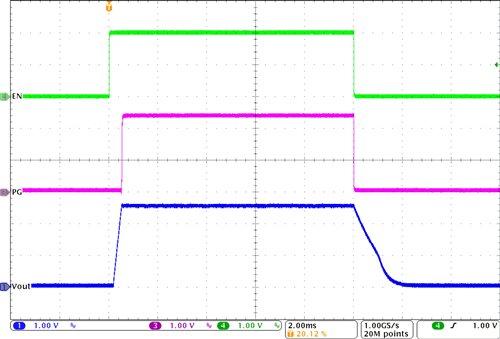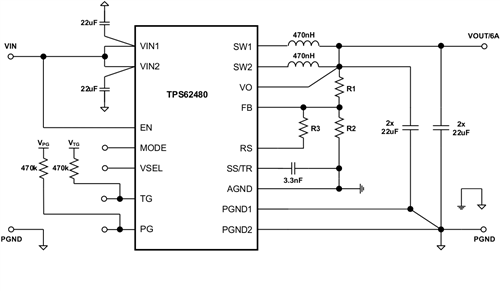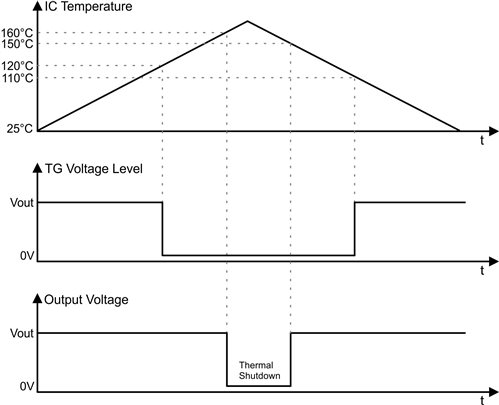SSZTAS6 october 2016 TPS62480
Looking back on DC/DC power supplies, the power-good (PG) function has been well-known for many years. The PG pin is an open-drain output that requires a pull-up resistor connected to the output voltage or any other system voltage. It is used in many applications to indicate whether the output voltage has reached an appropriate level or not. When the DC/DC converter reaches the right output-voltage level, the PG pin goes into a high impedance state and the signal goes high. The PG signal can monitor the correct output voltage or for the startup sequencing of multiple rails. Figure 1 shows a typical waveform of PG functionality during startup, operation and shutdown of the IC.
 Figure 1 PG Operation in the TPS62480
Figure 1 PG Operation in the TPS62480Besides the well-known PG feature, there is a new function available called thermal good (TG). The TG pin is also an open-drain output, like the PG, that requires a pull-up resistor. While the PG signal depends on the device’s output voltage, the TG signal depends on IC temperature. As long as the junction temperature is below the TG threshold temperature, the logic level at the TG pin is high. If the junction temperature exceeds that temperature, the TG pin goes low.
With TG, the system can take action to prevent excessive heating or even thermal shutdown. For example, if the temperature increases due to intense power demand from a processor and the TG signal goes low, a host MCU can reduce the operating frequency of the processor, which will draw less current and thus less heating, increasing power-supply reliability and preventing thermal shutdown.
Figure 2 shows a typical application schematic of the TPS62480, a 5V, 6A dual-phase step-down converter that implements this new TG function.
 Figure 2 TPS62480 Typical Application Schematic (PG and TG Pulled up
to VOUT)
Figure 2 TPS62480 Typical Application Schematic (PG and TG Pulled up
to VOUT)For this device, the TG threshold temperature is typically 120°C with a hysteresis of 10°C. So when the IC temperature is below 120°C, the logic level at the TG pin is high. The thermal shutdown temperature is 160°C with 10°C hysteresis for this IC. Because the recommended operating conditions limit the junction temperature to 125°C, the TG output can ensure that the device is always operating within the recommended junction temperature.
Figure 3 demonstrates the operation of the TG function. It’s based on the typical application circuit of Figure 2, where the TG pin pulls up to the TPS62480’s output voltage. An example rising and falling temperature profile shows the TG function as well as the thermal shutdown.
 Figure 3 TG Behavior
Figure 3 TG BehaviorBesides the TG and PG features, the TPS62480 provides a voltage select (VSEL) pin to easily adjust the output voltage between two levels and comes in a quad-flat no-lead (QFN)-style, easy-to-assemble HotRod™ package.
When do you start using the thermal good feature to increase system reliability?
Additional Resources
- Learn more about TI’s buck converters.
- Read how optical networks can benefit from the TPS62480 feature set in the blog post, “An easy-to-assemble power supply for optical modules.”